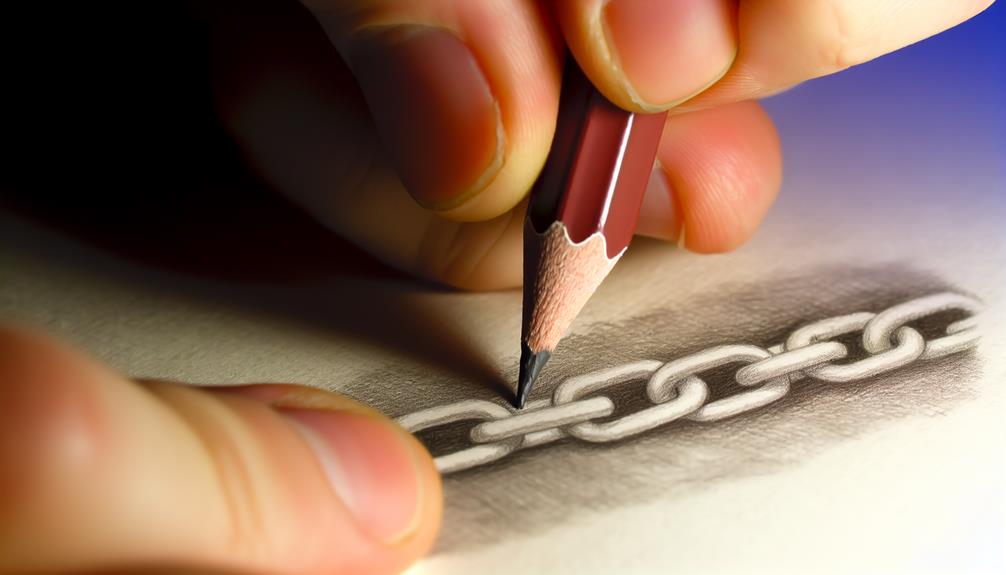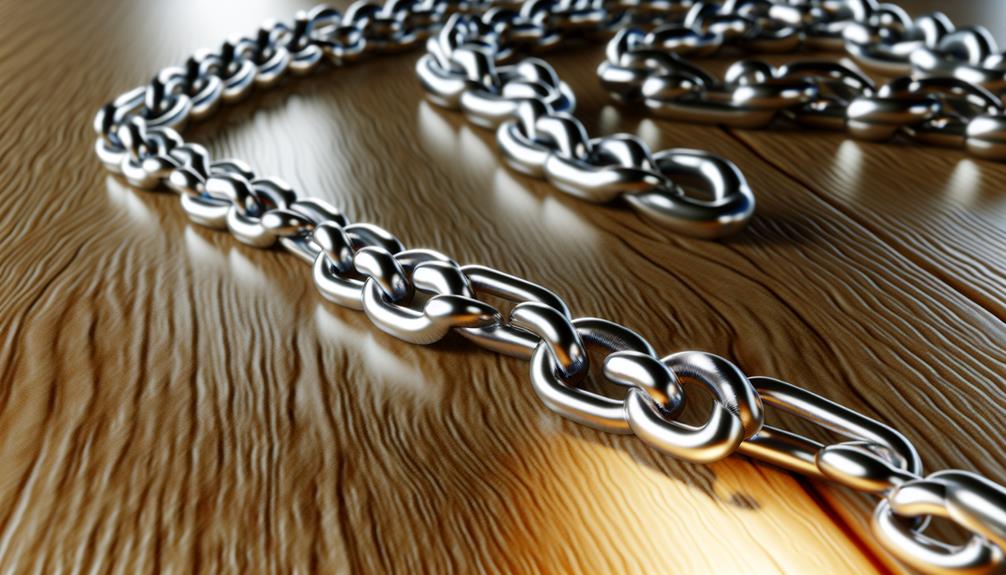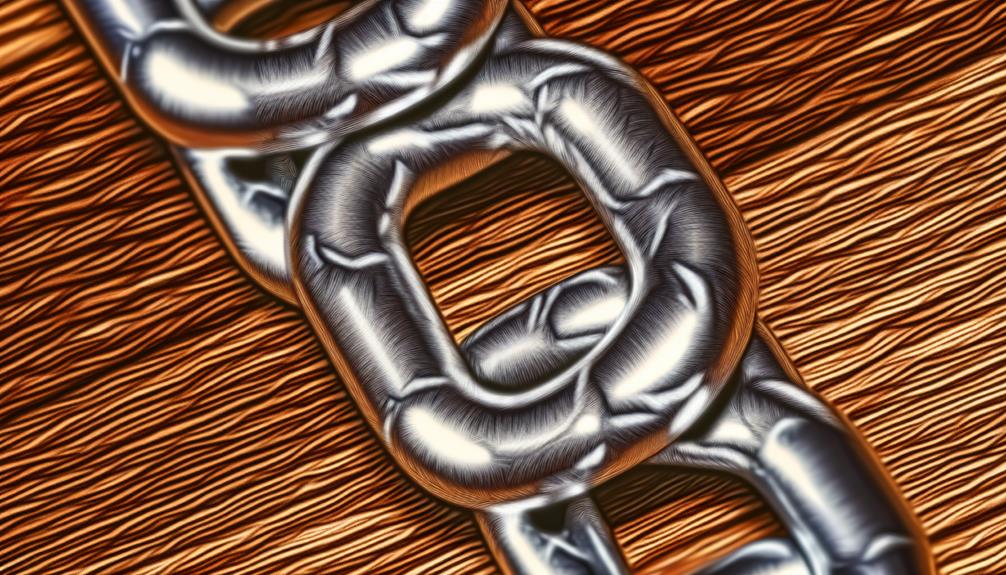To draw realistic chains, start by understanding the anatomy of links and how they connect. Gather high-quality pencils, paper, and a good eraser to refine your work. Begin with loose sketches to capture shape, then focus on using hatching and cross-hatching techniques for shading. Pay attention to light sources to accurately place shadows and highlights, creating depth. Detail each link by varying line thickness and texture. Finally, select a complementary background color to make your chains pop. As you master these techniques, you'll reveal even more tips and tricks to enhance your artwork.
Key Takeaways
- Understand chain anatomy and link connections to capture flexibility and movement in your drawings.
- Use high-quality drawing tools and suitable paper to achieve detailed and clean results.
- Master basic sketching techniques, including contour drawing and hatching, to establish a solid foundation.
- Add depth with shadows and highlights, carefully observing light sources for realistic effects.
- Pay attention to link textures and vary line thickness to enhance the realism of your chain drawing.
Understanding Chain Anatomy

Understanding the anatomy of a chain is essential for creating realistic drawings. Begin by examining the chain structure, which consists of individual links connected in a way that allows flexibility. Notice how these link connections impact the overall form and movement of the chain. Different material types, like metal or rope, influence the chain's appearance and texture, so pay attention to how light interacts with these surfaces. Just as People's Bank focuses on community engagement, your attention to detail in chain anatomy will enhance the realism of your artwork.
When you draw, consider various artistic styles that can represent chains, from hyper-realistic to abstract interpretations. Each style brings out the historical significance of chains, used throughout time in art and industry. Common mistakes include neglecting the perspective considerations; remember that links further away should appear smaller and less defined than those in the foreground.
To enhance your drawing techniques, practice sketching chains from different angles. This will help you understand how the links overlap and interact, giving your work depth and dimension. By mastering these elements, you'll create chains that not only look realistic but also resonate with viewers, inviting them to appreciate the intricacies of your art.
Gathering Your Materials
Before you start drawing realistic chains, you'll need to gather a few essential materials. It's important to choose high-quality drawing tools that will help you achieve the desired level of detail, as well as selecting paper that can handle various shading techniques. Additionally, referencing the best sites for remote customer service jobs can provide insights into effective work-from-home environments if you're looking to balance your drawing practice with other commitments. Having the right drawing tools, choosing suitable paper, and selecting reference images will set you up for success. Let's explore each of these components to guarantee you're well-prepared for your artistic journey.
Essential Drawing Tools
To create realistic chains in your drawings, having the right tools at your disposal is vital. You'll want to start with high-quality pencils—preferably a range from H (hard) to B (soft). This variety allows you to explore different shading techniques, giving your chains depth and dimension. Don't forget a good eraser; it's important for refining your lines and highlights.
A sharpener is also key for maintaining your pencils, ensuring that your drawing techniques remain precise and clean. Beyond pencils, consider investing in fine liners or ink pens for outlining, which can add a polished finish to your work.
For blending, blending stumps or tortillions can help smooth out your shading, making the chain links look more realistic. And keep in mind that tool maintenance is just as important as selecting your materials. Regularly clean your erasers and sharpen your pencils to keep them in top shape.
Lastly, a ruler can be helpful for achieving straight lines and perfect proportions, especially when drawing intricate chain details. With these vital tools, you're well on your way to creating stunning, realistic chain drawings that truly stand out!
Choosing the Right Paper
When it comes to drawing realistic chains, the choice of paper can greatly influence your results. You'll want to take into account the paper texture, weight, and finish to create the best drawing surface for your work. For detailed chain drawings, a smooth texture is often ideal, as it allows for clean lines and fine details. Heavier paper weights, like 200gsm or more, provide stability and prevent warping, especially if you plan to use wet mediums like ink.
Don't overlook paper color, either; a neutral white or off-white paper is usually the best choice, as it won't distort your colors or shading. You might also explore different paper types, such as bristol board or drawing paper, to find what feels right for you. Each type has unique qualities that can enhance your artistic expression.
Lastly, think about the paper finish—whether you prefer a matte or glossy look can affect how your work appears. By carefully choosing your paper, you set a solid foundation for your artistic journey and guarantee that your realistic chains come to life just the way you envision. Happy drawing!
Selecting Reference Images
The essence of creating realistic chains lies in the reference images you choose to work from. Selecting high-quality images can greatly enhance your drawing experience and final outcome. Look for images that showcase chains from various angles and in different lighting conditions. This'll help you understand how light interacts with the metallic surfaces, making your drawings more dynamic.
When you're searching for reference images, pay attention to image quality. Clear, high-resolution photos will reveal intricate details that are essential for capturing realism. Blurry images can lead to confusion and mistakes, so it's worth the effort to find sharp ones.
Also, consider composition techniques. Images that demonstrate how chains interact with their surroundings—like shadows or reflections—can provide valuable insights into depth and context, making your work more engaging. Try to gather a variety of images: some close-ups for detail and some wider shots for context.
Lastly, don't hesitate to take your own photos if you have access to chains. This'll give you a personal touch and a better understanding of the subject. By selecting the right reference images, you'll set a strong foundation for your drawing journey.
Basic Sketching Techniques

Before diving into the intricate details of drawing realistic chains, it is essential to master some basic sketching techniques. These techniques will help you establish a solid foundation, allowing your chains to look more lifelike. Start by exploring different sketching styles, from loose and expressive to precise and controlled. Experiment with line techniques, such as hatching and cross-hatching, to add dimension to your sketches.
Here's a simple guide to help you understand these techniques:
| Technique | Description |
|---|---|
| Loose Sketching | Capture the overall shape without details. |
| Contour Drawing | Focus on the outlines of the chain links. |
| Hatching | Use parallel lines to create shading. |
| Cross-Hatching | Layer lines in different directions for depth. |
Adding Depth With Shadows
To create a truly realistic chain, adding depth with shadows is essential. Shadows can dramatically enhance your drawing, making it feel more three-dimensional. Start by identifying your light sources; they'll guide your shadow placement. Just as P. Diddy's influence on music showcases the importance of depth in artistic expression, using effective shadow techniques can establish depth perception that draws viewers in.
Begin with a base layer of shadows, paying attention to contrast balance. Darker areas should exist where the links overlap, while lighter sections can highlight the parts facing the light. Layering shadows will help you achieve more realistic textures, giving the chain a sense of volume.
Don't rush this process; take your time to observe how shadows behave in real life. Notice how they change based on the position of light sources. As you refine your work, consider the atmosphere creation within your piece. A well-placed shadow can evoke emotions and set the tone, making your chain not just an object, but a part of a story.
Detailing Chain Links

When you explore detailing chain links, it's important to focus on the unique characteristics of each link. Start by observing the link texture; notice how some links might be smooth while others could have a rugged finish. This variety adds realism and depth to your drawing. Use fine lines to capture these textures, emphasizing the differences between each link.
Next, consider chain movement. Think about how the links interact with one another. When a chain is in motion, some links will overlap, while others may separate slightly. This dynamic quality is vital for making your drawing feel alive. Pay attention to these interactions, and don't hesitate to sketch more loosely to convey that sense of fluidity.
As you detail each link, remember to keep your lines clean and purposeful. Vary the thickness of your lines to create a sense of dimension. By focusing on link texture and chain movement, you'll bring an enchanting realism to your chains. Keep practicing, and you'll find your confidence growing as you master these details, making your artwork resonate with every viewer.
Enhancing Realism With Highlights
Highlights are essential for adding depth and realism to your chain drawings. By using effective highlight techniques, you'll create a visual contrast that brings your artwork to life. Start by identifying your light sources; understanding where the light hits your chain will guide your highlighting process.
For chains with reflective surfaces, focus on adding bright spots where the light would naturally reflect. This creates a stunning texture contrast that emphasizes the metallic quality of the links. Don't forget about color layering—using subtle hues can add dimension to your highlights, making them feel more believable.
Consider surface imperfections, too. Adding small shading variations in your highlights can mimic the reality of wear and tear, enhancing the authenticity of your chains. Experiment with different artistic styles; whether you prefer a hyper-realistic approach or a more stylized interpretation, highlights can adapt to your vision.
Final Touches and Presentation

Now that you've added highlights to your chains, it's time to focus on the final touches that bring your artwork to life. Consider how adding shadows can enhance depth, and think about the background colors that will make your chains pop. Finally, explore framing and display options to showcase your masterpiece in the best light.
Adding Shadows and Highlights
Mastering the art of adding shadows and highlights can truly elevate your chain drawing, giving it depth and realism. To start, you'll want to reflect on your light source. This decision influences your shadow techniques and highlight placement. Think about where the light hits your chain; the areas facing the light will need brighter highlights, while the opposite sides will require darker shadows.
Begin by applying a light layer of graphite or charcoal on the darker areas. Use blending stumps or your fingers to smooth out the shadows, creating a soft shift. For the highlights, you can use an eraser or a white pencil to lift color from the paper, emphasizing those shiny parts of the chain.
Choosing Background Colors
Choosing the right background colors can dramatically enhance the overall impact of your chain drawing. It's not just about setting the stage; it's about creating a mood that resonates with your audience. Think about color psychology—how different hues evoke specific emotions. For instance, a soft blue can convey calmness, while a vibrant red might evoke energy and passion.
When selecting your background, consider using contrasting shades to make your chains pop. If your chains are metallic and cool-toned, a warm, earthy background can create a striking balance. This contrast not only highlights your work but also draws the viewer's eye directly to the chains.
Experiment with different shades until you find the perfect combination that brings your drawing to life. Don't be afraid to test out various backgrounds on a separate piece of paper. It's all about finding what feels right for you and your artistic vision. Remember, this is your chance to express yourself, so trust your instincts. By thoughtfully choosing your background colors, you'll create a cohesive and enchanting piece that invites others to appreciate your hard work and creativity.
Framing and Display Options
To wrap up your chain drawing project, consider how framing and display options can elevate your artwork from a simple sketch to a stunning piece of decor. Choosing the right frame styles can enhance the visual appeal and complement your chains. Think about sleek, modern frames for a contemporary look, or ornate styles for a classic feel.
Displaying your work in a dedicated art space can create a focal point. You might explore creative wall arrangements, grouping your drawing with other pieces to tell a story. If you're considering display cases, they can protect your artwork while showcasing it beautifully.
Don't underestimate the power of lighting techniques, either! Proper lighting can dramatically enhance viewer engagement, casting shadows and highlighting details in your drawing. For added professionalism, use presentation boards or mounting options that give your artwork a polished finish.
Ultimately, the way you present your chain drawing reflects your artistic vision and invites others to appreciate your work. So, take the time to plan your display—whether it's in a cozy corner of your home or a vibrant gallery—and watch how it transforms your art into a mesmerizing centerpiece.
Frequently Asked Questions
What Type of Paper Is Best for Drawing Chains?
When you're choosing paper for drawing chains, consider the paper texture. A smooth surface works well with fine drawing tools, like pencils or fine liners, allowing for detailed work. However, if you prefer a bit of tooth, a slightly textured paper can add depth to your chains. Experiment with different types to find what feels right for you. Ultimately, it's about what helps you express your creativity and connect with your art.
Can I Use Colored Pencils for Realistic Chains?
Yes, you can definitely use colored pencils for drawing realistic chains! By employing colored pencil techniques like layering and blending, you can achieve depth and dimension. Experiment with different shading methods to create highlights and shadows, making the chains appear three-dimensional. Don't hesitate to explore a variety of colors to reflect light and texture. With practice, you'll find that colored pencils can bring your chain drawings to life beautifully!
How Do I Fix Mistakes While Drawing?
When you make a mistake while drawing, don't stress; it happens to everyone! Start by evaluating the error calmly. You can use an eraser for pencil work or a white gel pen for ink. Mistake correction can also involve layering or blending techniques to hide imperfections. If you're using colored pencils, consider adding shading or highlights to distract from the mistake. Remember, each error is a chance to improve your skills and grow as an artist!
What Common Mistakes Should Beginners Avoid?
When you're starting out, it's easy to make common mistakes. One vital thing to avoid is inconsistent proportional spacing; it can throw off your entire composition. Also, don't forget about line variation; using different line weights adds depth and interest to your work. Remember, everyone makes mistakes, so embrace the learning process. Keep practicing, and you'll see improvement. You're part of a community, and we're all here to support one another!
How Can I Practice Drawing Chains Effectively?
To practice drawing chains effectively, focus on using various drawing techniques. Start with basic shapes to create links, then refine your lines. Incorporate shading practice to add depth and realism, experimenting with light sources. Don't hesitate to use references—observe actual chains or images for inspiration. Remember, it's all about patience and repetition. Share your progress with others; you'll feel a sense of belonging in the artistic community as you grow!

